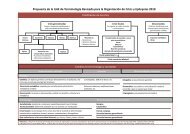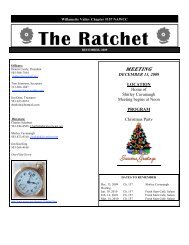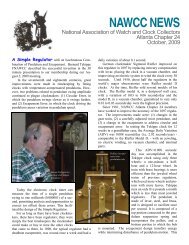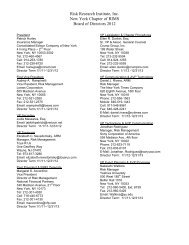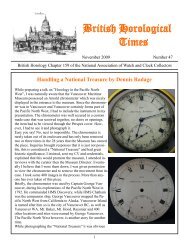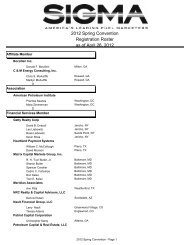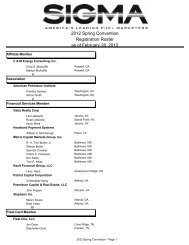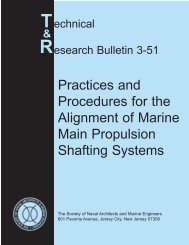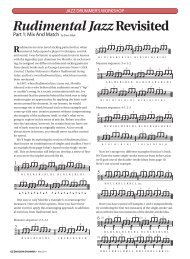Nana Vasconcelos: The Voice of the Berimbau
Nana Vasconcelos: The Voice of the Berimbau
Nana Vasconcelos: The Voice of the Berimbau
Create successful ePaper yourself
Turn your PDF publications into a flip-book with our unique Google optimized e-Paper software.
naná vasconcelos<br />
with trio manari<br />
Evening Concert<br />
Friday, 9:00 p.m.<br />
Naná <strong>Vasconcelos</strong> is one <strong>of</strong> Brazil’s<br />
most famous percussionists, and is<br />
probably <strong>the</strong> world’s most famous<br />
virtuoso <strong>of</strong> <strong>the</strong> berimbau. His musical career<br />
spans over five decades, and <strong>the</strong> list <strong>of</strong> musicians<br />
with whom he has collaborated and<br />
recorded is enormous. His most famous<br />
and noteworthy projects include work with<br />
Milton Nascimento, his trio Codona (Colin<br />
Walcott, Don Cherry, and Naná), <strong>the</strong> Pat<br />
Me<strong>the</strong>ny Group, Egberto Gismonti, Jan<br />
Garbarek, and his own solo recordings.<br />
For <strong>the</strong> past eight years, <strong>Vasconcelos</strong> has<br />
been living and working in his hometown<br />
<strong>of</strong> Recife, capital <strong>of</strong> <strong>the</strong> nor<strong>the</strong>astern state <strong>of</strong><br />
Pernambuco, Brazil. His current undertakings<br />
include <strong>the</strong> formation <strong>of</strong> a new band<br />
<strong>of</strong> talented young musicians with whom<br />
he has recorded <strong>the</strong> album Chegadas (2005)<br />
and who is currently developing a second<br />
record; yearly Carnaval activities as <strong>the</strong><br />
master <strong>of</strong> opening ceremonies, working<br />
with <strong>the</strong> 1,600+ drummers involved in <strong>the</strong><br />
local maracatu groups; and a project with<br />
children’s choir and symphony orchestra,<br />
ABC Musical.<br />
His last published interview in an American<br />
journal dates from July 2000. N. Scott<br />
naná vasconcelos with Greg Beyer<br />
percussive notes 48 octoBer 2007<br />
Naná <strong>Vasconcelos</strong><br />
<strong>The</strong> <strong>Voice</strong> <strong>of</strong> <strong>the</strong> <strong>Berimbau</strong><br />
By GreG Beyer<br />
Robinson published “<strong>The</strong> Nature <strong>of</strong> Naná”<br />
in Modern Drummer, roughly coinciding<br />
with Naná’s departure from New York<br />
and relocation to Recife. In that insightful<br />
interview, Naná points to <strong>the</strong> berimbau as<br />
<strong>the</strong> instrument that has guided his musical<br />
development and career: “Everything<br />
I do stems from <strong>the</strong> berimbau. Sometimes<br />
I ask myself, ‘Why me? Why was I given<br />
<strong>the</strong> berimbau and why do I play it <strong>the</strong> way<br />
I do?’ <strong>The</strong> berimbau is <strong>the</strong> main thing that<br />
influences all <strong>of</strong> my percussion playing.”<br />
Over a period <strong>of</strong> three days, from August<br />
19–21, 2007, Naná invited me into his home<br />
simply to spend time getting to know one<br />
ano<strong>the</strong>r. His gracious and generous manner<br />
led to a three-hour interview session in<br />
which he revealed once again his mercurial<br />
character, his fascination with nature,<br />
sound and music, and his energy and reverence<br />
for <strong>the</strong> creative spirit.<br />
GB: To begin, can you briefly talk about your<br />
early musical experiences growing up?<br />
NV: My earliest musical memory comes<br />
from <strong>the</strong> maracatus that are an important<br />
part <strong>of</strong> African culture in Recife. <strong>The</strong>se<br />
drumming groups come out to perform<br />
Photo by Erin LEssEr<br />
at Carnaval time. <strong>The</strong> deep sounds <strong>of</strong><br />
those drums, like thunder, have stayed<br />
with me and have influenced a lot <strong>of</strong> my<br />
instrument choices. I have a lot <strong>of</strong> low<br />
sounds—<strong>the</strong> gong, <strong>the</strong> talking drum, <strong>the</strong><br />
berimbau…this thing about <strong>the</strong> drone,<br />
<strong>the</strong> OM. [Naná begins intoning, “OM.”]<br />
For me, this runs deep.<br />
I started playing music pr<strong>of</strong>essionally<br />
with my fa<strong>the</strong>r, Pierre, at local dance<br />
cabarets when I was 12 years old. I was<br />
banging pots and pans around <strong>the</strong> house,<br />
so my mo<strong>the</strong>r allowed my fa<strong>the</strong>r to take<br />
me to work with him. We needed to<br />
obtain a special police permit for me to<br />
enter <strong>the</strong>se establishments, and I wasn’t<br />
allowed to leave <strong>the</strong> stage! With my<br />
fa<strong>the</strong>r we played a lot <strong>of</strong> Cuban dance<br />
music, and my first instruments were<br />
maracas and bongo.<br />
Soon after I began to listen to a lot <strong>of</strong><br />
American jazz through <strong>the</strong> radio station<br />
<strong>Voice</strong> <strong>of</strong> America. My heroes were people<br />
like Ornette Coleman, <strong>The</strong>lonious Monk,<br />
and Dave Brubeck. I bought myself a<br />
drumset and taught myself how to play<br />
it.<br />
It is funny because I won a competition<br />
here in Recife. I won best drummer just<br />
because I could play in different time signatures.<br />
I used to listen to a lot <strong>of</strong> Dave<br />
Brubeck’s quartet—“Take Five,” “Blue<br />
Rondo a la Turk,” all those things in five,<br />
seven, nine, etc. And so I put all <strong>the</strong>se different<br />
time signatures into <strong>the</strong> samba.<br />
GB: So <strong>the</strong> music <strong>of</strong> Dave Brubeck influenced<br />
you to start playing Brazilian musical styles<br />
in odd time signatures?<br />
NV: Yes, Dave Brubeck influenced me to<br />
start thinking that way. It was Brubeck,<br />
Paul Desmond, Joe Morello—that band.<br />
This was one side <strong>of</strong> <strong>the</strong> development<br />
<strong>of</strong> my style. <strong>The</strong> o<strong>the</strong>r side was Africa. I<br />
had <strong>the</strong> whole culture <strong>of</strong> <strong>the</strong> candomblés.<br />
I knew all <strong>the</strong> rhythms <strong>of</strong> <strong>the</strong> African<br />
orixás and I put those on my drums.<br />
GB: But eventually you stopped playing <strong>the</strong><br />
drums in favor <strong>of</strong> percussion. Let’s talk about<br />
your work with <strong>the</strong> berimbau. You began
naná playing with trio nordeste. recife, 1968.<br />
playing <strong>the</strong> instrument because <strong>of</strong> a <strong>the</strong>atre<br />
show in Recife called A Memoria dos Cantadores<br />
(Memory <strong>of</strong> <strong>the</strong> Singers). What year<br />
was that show?<br />
NV: It was in 1964–65, during <strong>the</strong> great<br />
period <strong>of</strong> musical <strong>the</strong>atre here in Brazil.<br />
<strong>The</strong> show was meant as a way to show<br />
all <strong>the</strong> different folk musics and cultures<br />
from around <strong>the</strong> Nor<strong>the</strong>ast <strong>of</strong> Brazil. So<br />
<strong>the</strong>re was music from Ceará in <strong>the</strong> north,<br />
Amazonas also in <strong>the</strong> north, and <strong>the</strong>n <strong>the</strong><br />
Nor<strong>the</strong>ast, Paraíba, Alagoas, and <strong>the</strong>n<br />
finally Bahia. Capoeira was <strong>the</strong> music<br />
chosen to represent Bahia. So for this I<br />
started to learn berimbau.<br />
GB: So you were in your early twenties when<br />
you started playing <strong>the</strong> berimbau. Did you<br />
travel to Bahia to find your instrument?<br />
NV: No, I found it here in <strong>the</strong> market in<br />
Recife. Capoeira is common here, too,<br />
although Salvador is <strong>the</strong> recognized capital<br />
<strong>of</strong> capoeira. For <strong>the</strong> show, I learned<br />
<strong>the</strong> music <strong>of</strong> capoeira, but <strong>the</strong>re are very<br />
few rhythms involved in traditional play.<br />
But after Memoria dos Cantadores, <strong>the</strong><br />
berimbau stayed with me, and I started<br />
to think that it didn’t have to only play<br />
those rhythms.<br />
GB: You moved from Recife to Rio, where you<br />
met Milton Nascimento and that changed <strong>the</strong><br />
course <strong>of</strong> your career.<br />
NV: I never “left” Recife! [laughs] I was just<br />
going to Rio for one week to play in a<br />
festival, O Brazil canta no Rio, and I never<br />
came back. It has always been like that,<br />
you know. I just leave. When I went to<br />
<strong>the</strong> States it was also like that. Paris, too.<br />
I convinced a composer I was working<br />
with that <strong>the</strong> drummers in Rio didn’t<br />
know how to play maracatu, so he<br />
invited me to go to this festival with him.<br />
In <strong>the</strong> middle <strong>of</strong> <strong>the</strong> festival <strong>the</strong>re was a<br />
party at Milton Nascimento’s house, and<br />
Geraldo Azevedo, whom I had worked<br />
with in A Memoria dos Cantadores, introduced<br />
me to Milton.<br />
GB: Did you know Milton’s music already?<br />
NV: No. I knew about his reputation. <strong>The</strong>re<br />
was a big buzz around him already.<br />
Everyone was talking about <strong>the</strong> new<br />
thing, Milton Nascimento. He had a new<br />
way to harmonize, to think about music.<br />
Everyone at that time was playing bossa<br />
nova, and Milton was something else,<br />
something different. I liked that, because<br />
I felt that I, too, had something different<br />
to say, in <strong>the</strong> sense that my drumming<br />
was different than what everybody was<br />
playing in Rio. I wasn’t going to play <strong>the</strong><br />
bossa nova that way because I couldn’t<br />
play it that way, but I knew different<br />
things coming from <strong>the</strong> Nor<strong>the</strong>ast.<br />
So Geraldo introduced me to Milton,<br />
and I told him, “Listen, I came here to<br />
play with you.” [laughs]<br />
percussive notes 49 octoBer 2007
GB: <strong>The</strong> story is that you jammed with him on<br />
pots and pans from <strong>the</strong> kitchen on his tune<br />
“Sentinela.”<br />
NV: Yes, and his response was, “Hey, what<br />
are you doing on Monday?” So I started<br />
to compose rhythms for his songs.<br />
GB: <strong>The</strong> berimbau was one <strong>of</strong> many instruments<br />
you used when you recorded with<br />
Nascimento. What was it about <strong>the</strong> berimbau<br />
that drew you to it, that made you start to<br />
adapt your drumset ideas to this instrument?<br />
NV: Well, when I moved to Rio I lived in an<br />
apartment, so it was impossible for me<br />
to play drums! So I started to play <strong>the</strong><br />
berimbau. And it drew me in.<br />
<strong>The</strong> berimbau is very spiritual. <strong>The</strong><br />
sound <strong>of</strong> <strong>the</strong> berimbau comes from inside.<br />
And <strong>the</strong> whole connection—<strong>the</strong> energy<br />
is in <strong>the</strong> chakra here [Naná indicates his<br />
chest and lung cavity]. Before, I didn’t<br />
know about <strong>the</strong>se things, but even <strong>the</strong>n I<br />
felt something, some energy here [again<br />
he indicates his chest and this time exhales<br />
deeply and slowly]. My chest, my<br />
heart, everything leaves from here and<br />
percussive notes 50 octoBer 2007<br />
goes outward. So <strong>the</strong> sound <strong>of</strong> <strong>the</strong> berimbau<br />
takes you to a calm place where you<br />
can be quiet inside yourself. You can<br />
listen to your inner silence. It is like a<br />
meditation almost; <strong>the</strong> sound makes you<br />
so peaceful and at <strong>the</strong> same time it strikes<br />
very deep. <strong>The</strong> sound <strong>of</strong> <strong>the</strong> berimbau is<br />
very deep. You have to really get in, get<br />
in very deep to feel it.<br />
It is a very simple instrument, but it is<br />
very deep, very rich. Something <strong>of</strong> nature<br />
is in that sound.<br />
GB: I understand that you made your own<br />
instrument—that <strong>the</strong> instrument you picked<br />
up in <strong>the</strong> market in Recife is not <strong>the</strong> same<br />
instrument you play today.<br />
NV: I started to think about <strong>the</strong> soul <strong>of</strong><br />
<strong>the</strong> berimbau, and something told me<br />
I needed to make my own instrument.<br />
So when I was living in Rio, I went to<br />
<strong>the</strong> forest, cut my own beriba wood,<br />
prepared <strong>the</strong> wood just so… I did everything.<br />
I even discovered at that time that<br />
<strong>the</strong> wire should be piano wire. I already<br />
thought about that at that time. And it<br />
was very difficult in Brazil to find piano<br />
wire. I had to find somebody who was a<br />
piano tuner and beg <strong>the</strong>m for wire!<br />
So <strong>the</strong> berimbau was incredibly important<br />
for me, because it made me realize<br />
that I have something that o<strong>the</strong>rs don’t<br />
have. It gave me <strong>the</strong> voice to contribute<br />
something original to a given context.<br />
I could suddenly play with jazz musicians<br />
in an original way. Shortly after I<br />
recorded with Milton, I played with Gato<br />
Barbieri, and he gave me a little solo during<br />
<strong>the</strong> concert, and <strong>the</strong>re I realized that I<br />
had something totally different.<br />
<strong>The</strong>n I started to think about how I<br />
could develop my ideas on <strong>the</strong> berimbau.<br />
And <strong>the</strong> berimbau started to give me<br />
ideas that I could translate to <strong>the</strong> o<strong>the</strong>r<br />
instruments that I play—congas, cuica,<br />
pandeiro, o<strong>the</strong>r instruments I made<br />
myself, thinking about sounds.<br />
GB: And thinking also about imagery? You<br />
mention Villa-Lobos as an important influence…<br />
NV: Yes, Villa-Lobos’ compositions are very<br />
powerful visually. In <strong>the</strong> “tocatta” <strong>of</strong> “Bachianas<br />
Brasileiras no. 2,” he imagined<br />
a trenzinho caipira. He wrote everything<br />
on <strong>the</strong> page, and yet it sounds like he’s<br />
constructed a train, and he puts you<br />
inside, and from <strong>the</strong> train you can see <strong>the</strong><br />
entire Brazilian landscape. It is amazing.<br />
Villa-Lobos’ music has this power, and I<br />
do try to put that imagery into my music.<br />
I’ve known his music for a long time. My<br />
fa<strong>the</strong>r listened to him in <strong>the</strong> house, so I<br />
knew this music from my childhood.<br />
GB: Did you talk to your fa<strong>the</strong>r about this<br />
imagery?<br />
NV: No, my fa<strong>the</strong>r died when I was very<br />
young. He never saw me play <strong>the</strong> drums;<br />
he never saw me play all <strong>the</strong>se things.<br />
GB: <strong>The</strong> earliest examples <strong>of</strong> your work with <strong>the</strong><br />
berimbau in <strong>the</strong> music <strong>of</strong> Milton Nascimento<br />
are two bonus tracks on a re-released<br />
version <strong>of</strong> Milton (1970). On both <strong>of</strong> <strong>the</strong>se<br />
tracks, “Tema de Tostão” and “O Homem da<br />
Sucursal,” <strong>the</strong> tuning <strong>of</strong> <strong>the</strong> instrument is<br />
identical and seems to bear to no relationship<br />
to <strong>the</strong> prevailing harmony <strong>of</strong> <strong>the</strong> music you<br />
are playing. Were you thinking about tuning<br />
at that time?<br />
NV: No, not yet. It was just an instrument.<br />
It was only later when I started to think<br />
about writing pieces for <strong>the</strong> instrument<br />
that I thought about tuning <strong>the</strong> berimbau.
GB: Pieces that resulted in your first solo<br />
album, Africadeus (1972)?<br />
NV: Yes. With <strong>the</strong> berimbau I started to feel<br />
like I was on a mission. First I started to<br />
experiment with different rhythms—different<br />
from capoeira. That was scary at<br />
first, because <strong>the</strong> berimbau in Brazil is<br />
capoeira. And capoeira is a tradition, and<br />
nobody can fool around with tradition—<br />
a tradition you must respect, because<br />
it has to do with religion, with Africa. I<br />
was scared to play berimbau differently<br />
because people would say, “Oh, you are<br />
messing with tradition.” So I started to<br />
play <strong>the</strong>se solos more outside <strong>of</strong> Brazil,<br />
ra<strong>the</strong>r than inside.<br />
GB: Shortly after <strong>the</strong>se early Milton recordings<br />
you did, in fact, leave Brazil.<br />
NV: Because <strong>of</strong> <strong>the</strong> work I did with Milton,<br />
I started to get a lot <strong>of</strong> phone calls. Gato<br />
Barbieri, <strong>the</strong> Argentinean jazz saxophone<br />
player, asked me to do a tour <strong>of</strong> Argentina<br />
with him. Less than a week into <strong>the</strong><br />
tour, he asked if I wanted to go to New<br />
York City to record an album. Suddenly<br />
I was in New York City, and I ended up<br />
staying <strong>the</strong>re for ten months.<br />
<strong>The</strong>n I went on a tour with Gato<br />
through Europe, and at <strong>the</strong> end <strong>of</strong> <strong>the</strong><br />
tour I had this feeling. We played in<br />
Rome, and <strong>the</strong>n flew back to Paris to<br />
catch <strong>the</strong> flight back to New York. And<br />
at <strong>the</strong> airport I said, “Gato, thank you for<br />
everything. I’m not going back to New<br />
York; I’m going to stay here.” Because I<br />
felt like, “I have something; I have to do<br />
something by myself.” And I thought to<br />
myself, “If nothing happens, I’ll go back<br />
to Brazil and play with Milton Nascimento.”<br />
But after three days in Paris, a lot <strong>of</strong><br />
things started to happen. This guy came<br />
looking for me, Pierre Barouh, who did<br />
<strong>the</strong> film A Man and a Woman (1966).<br />
<strong>The</strong> rhythmic work I was doing with<br />
<strong>the</strong> berimbau, using odd time signatures,<br />
etc., eventually led to experimentations<br />
with sounds, <strong>the</strong>n <strong>the</strong> use <strong>of</strong> my<br />
voice with <strong>the</strong> berimbau. <strong>The</strong>n I started<br />
to think about composition. In Paris I<br />
wanted to put a solo show toge<strong>the</strong>r, to<br />
show what I could do with <strong>the</strong> berimbau.<br />
And <strong>the</strong>n I did Africadeus.<br />
GB: What strikes me about Africadeus is that<br />
it seems like between 1972 and 1979, when<br />
you recorded Saudades, <strong>the</strong>re is a radical<br />
difference <strong>of</strong> timbre, <strong>of</strong> sound quality, <strong>of</strong><br />
tuning. All <strong>of</strong> <strong>the</strong>se aspects <strong>of</strong> your work with<br />
berimbau seem to have clarified <strong>the</strong>mselves<br />
in between those two projects. A lot <strong>of</strong> <strong>the</strong><br />
rhythmic language is very similar on both<br />
records, but it is <strong>the</strong> quality <strong>of</strong> sound that<br />
has so drastically changed.<br />
NV: Yes, all those aspects became clearer.<br />
After Africadeus, I started to play with<br />
a lot <strong>of</strong> excellent musicians: Egberto<br />
Gismonti, Don Cherry, Colin Walcott.<br />
Working with o<strong>the</strong>r instrumentalists led<br />
me to <strong>the</strong> idea that I wanted to make a<br />
concerto for <strong>the</strong> berimbau with strings.<br />
That led to Saudades.<br />
Let me tell you a crazy story about <strong>the</strong><br />
berimbau from those years. In my early<br />
explorations with <strong>the</strong> berimbau, I spent<br />
a lot <strong>of</strong> time working on <strong>the</strong> wire, on <strong>the</strong><br />
verga (bow), on rhythmic patterns and<br />
more virtuosic playing. I used to spend<br />
hours and hours doing this, and one day<br />
<strong>the</strong> berimbau began to speak to me. I was<br />
working, working, working, and <strong>the</strong>n<br />
when I finally came out from playing so<br />
hard, I needed to come up for air, I physically<br />
needed to brea<strong>the</strong>. So I hit <strong>the</strong> open<br />
wire and simultaneously brea<strong>the</strong>d out,<br />
“wah-wah…”<br />
“Ooh!” [with surprise] Suddenly <strong>the</strong><br />
voice <strong>of</strong> <strong>the</strong> berimbau had opened up to<br />
me; its voice came through me. It said,<br />
“Wah-wah” [Naná plays open tone on <strong>the</strong><br />
wire], “psiu,” [he plays a hammer-on and<br />
-<strong>of</strong>f with <strong>the</strong> coin], and <strong>the</strong>n “ch-ch-chch-ah-ah-ah-ah”<br />
[he plays a rapid series<br />
<strong>of</strong> notes first on <strong>the</strong> verga, <strong>the</strong>n pressed<br />
against <strong>the</strong> inside <strong>of</strong> <strong>the</strong> wire]. That is<br />
how I discovered <strong>the</strong>se sounds from <strong>the</strong><br />
wire and <strong>the</strong> verga. I used <strong>the</strong>se sounds<br />
when I recorded Africadeus.<br />
Later, in <strong>the</strong> mid-’70s, I was on tour<br />
with Don Cherry and we had a performance<br />
in Klagenfurt, Austria. During<br />
down time, I went to <strong>the</strong> middle <strong>of</strong> a<br />
nearby forest and again worked all <strong>the</strong>se<br />
sounds. <strong>The</strong>n suddenly <strong>the</strong> cabaça began<br />
to speak to me. <strong>The</strong>re were two voices.<br />
One was agitated and aggressive: “Ahba-di-ga,<br />
ah-ba-di-ga, ah-ba-di-ga” [Naná<br />
rapidly sings this phrase in high voice<br />
while playing a fast tremolo with <strong>the</strong><br />
baqueta on <strong>the</strong> side <strong>of</strong> <strong>the</strong> cabaça]. <strong>The</strong><br />
o<strong>the</strong>r was murmuring and mumbling<br />
[Naná rubs <strong>the</strong> baqueta on <strong>the</strong> side <strong>of</strong> <strong>the</strong><br />
cabaça in slow, s<strong>of</strong>t circles, while s<strong>of</strong>tly<br />
mumbling unintelligible short phrases<br />
in Portuguese]. So <strong>the</strong>se two guys were<br />
carrying on, and <strong>the</strong>n suddenly an Indian<br />
came to me from <strong>the</strong> depth <strong>of</strong> <strong>the</strong> forest<br />
and said, “And now, I am here…” [Naná<br />
begins to slowly spin circles around <strong>the</strong><br />
gourd with <strong>the</strong> baqueta] “and I sound<br />
like this” [Naná begins to whistle a high<br />
pitch that slowly descends].<br />
GB: Those are instantly recognizable as your<br />
sounds. In o<strong>the</strong>r words, <strong>the</strong> spirit <strong>of</strong> <strong>the</strong><br />
berimbau spoke to you.<br />
NV: Yes, <strong>the</strong> berimbau spoke to me. <strong>The</strong>se<br />
two guys were having a conversation<br />
[Naná points to <strong>the</strong> gourd] and <strong>the</strong>n <strong>the</strong><br />
Indian spoke, “I am here” [again Naná<br />
whistles and spins circles around <strong>the</strong><br />
outside <strong>of</strong> <strong>the</strong> gourd].<br />
percussive notes 51 octoBer 2007
“But <strong>the</strong> sound isn’t here” [he points<br />
to his mouth], “you have to get it from<br />
here” [Naná points to <strong>the</strong> gourd, and<br />
begins to laugh]. Getting this sound depends<br />
upon your absolute equilibrium.<br />
You mustn’t drink, smoke, nothing. You<br />
must be clean. You train like this [Naná<br />
assumes a yoga-like pose, standing on<br />
his right leg only, lifting his left leg up<br />
<strong>of</strong>f <strong>the</strong> ground and planting <strong>the</strong> foot into<br />
<strong>the</strong> side <strong>of</strong> <strong>the</strong> right knee], and you try<br />
to achieve a perfect circle, and <strong>the</strong> spirit<br />
comes to you like this.<br />
Really crazy, that story, no?<br />
GB: Beautiful story. And so <strong>the</strong>n you recorded<br />
Saudades, and <strong>the</strong> concerto, “O <strong>Berimbau</strong>,”<br />
uses all those sounds.<br />
NV: Yes, I had Villa-Lobos and all <strong>the</strong>se<br />
o<strong>the</strong>r influences going on inside my<br />
head, and I decided I had to make a<br />
concerto for <strong>the</strong> berimbau.<br />
GB: And when you wrote “O <strong>Berimbau</strong>,” that<br />
was done in collaboration with Egberto Gismonti,<br />
right?<br />
NV: Yes. I knew what <strong>the</strong>mes I wanted to<br />
use in <strong>the</strong> orchestra. In <strong>the</strong> first section <strong>of</strong><br />
<strong>the</strong> string part, I used <strong>the</strong>mes based on<br />
traditional cattle calls from here in <strong>the</strong><br />
interior <strong>of</strong> <strong>the</strong> Nordeste, aboios. [Naná<br />
begins singing <strong>the</strong>mes that resemble<br />
melodic fragments from “O <strong>Berimbau</strong>”<br />
percussive notes 52 octoBer 2007<br />
and Cantando Historias.] And <strong>the</strong> second<br />
part for <strong>the</strong> strings, very angular and<br />
“modern”—well, that was Egberto.<br />
[laughs] I gave my ideas to him. He has<br />
conservatory training. I came from <strong>the</strong><br />
streets; I never went to school.<br />
GB: Escola de samba?<br />
NV: [laughs] Exactly. But I know <strong>the</strong> things<br />
that I want. I knew that I wanted to hear<br />
cello and viola. I love <strong>the</strong>se instruments<br />
and <strong>the</strong>ir sounds. I love <strong>the</strong> cello. It is<br />
fantastic. <strong>The</strong> timbre is so close to <strong>the</strong><br />
human voice. <strong>The</strong> timbre <strong>of</strong> both <strong>the</strong> cello<br />
and <strong>the</strong> viola match very beautifully with<br />
congas, hand drums, berimbau.<br />
GB: Many <strong>of</strong> <strong>the</strong> rhythmic patterns you played<br />
in “O <strong>Berimbau</strong>,” were ideas already present<br />
in Africadeus. <strong>The</strong> opening triplets, for<br />
example.<br />
NV: Yes, true. That opening idea for me is<br />
like an introduction, to show <strong>the</strong> instrument.<br />
You see, at that time I had to do a<br />
solo percussion show in a <strong>the</strong>atre. And<br />
<strong>the</strong> stereotypical thought <strong>of</strong> a solo percussion<br />
show is lots <strong>of</strong> fast drumming [air<br />
drums a big mess].<br />
I wanted to make music with percussion.<br />
I don’t try to play loud or fast.<br />
I tried to make sounds. So with that<br />
introduction, it was just a way to make<br />
an opening statement. I didn’t use <strong>the</strong><br />
Example 1. Excerpt from “O <strong>Berimbau</strong>.” Opening figure. Saudades (1979)<br />
caxixi yet, just <strong>the</strong> berimbau, just <strong>the</strong><br />
wire. To really show how to listen to <strong>the</strong><br />
instrument, I needed to come up with a<br />
<strong>the</strong>me—a way to organize my thoughts,<br />
to give time for <strong>the</strong> music to open up and<br />
develop, not to show everything right<br />
away.<br />
<strong>The</strong>n I developed a formula: first start<br />
with <strong>the</strong> wire, <strong>the</strong>n add <strong>the</strong> caxixi, <strong>the</strong>n<br />
open up <strong>the</strong> wire to play <strong>the</strong> length <strong>of</strong><br />
it, <strong>the</strong>n add <strong>the</strong> sounds <strong>of</strong> <strong>the</strong> staff and<br />
<strong>the</strong> gourd, <strong>the</strong>n add <strong>the</strong> voice. It was a<br />
formula to develop <strong>the</strong> whole sound <strong>of</strong><br />
<strong>the</strong> instrument, to show how rich this<br />
instrument is. [See Example 1]<br />
GB: When you play <strong>the</strong>se extra beats or odd<br />
time signatures, as for example in <strong>the</strong> 15/8<br />
bar, you added a fifth beat to <strong>the</strong> phrase. Did<br />
you do those things deliberately?<br />
NV: Yes. Because I have this idea that you<br />
don’t need to end one idea to start something<br />
else.<br />
GB: You blur <strong>the</strong> lines at points <strong>of</strong> transition?<br />
NV: Yes. I didn’t do this so much at that<br />
point, but nowadays, I frequently take<br />
phrases <strong>of</strong> seven, for example, and suddenly<br />
change <strong>the</strong>m to six, <strong>the</strong>n again to<br />
four. For example [see Example 2]:<br />
You see, I don’t stop an idea when I<br />
want to start ano<strong>the</strong>r one; I just go. When<br />
I finish one it is because I’ve already<br />
poco rit.<br />
V 8<br />
12 . ~~~ ~~~ ~~~ ~~~ .<br />
f œ œ œ œ œ œ œ œ œ œ œ œ œ œ œ œ œ œ œ œ œ œ œ œ œ ˙ . ˙ . ˙ . ˙.<br />
wah-wah<br />
V 8 15<br />
œ œ œ œ œ œ œ œ œ œ œ œ œ ‘ œ œ œ œ œ œ œ œ œ œ œ œ œ œ œ œ œ œ œ œ œ œ œ œ œ œ œ<br />
V 8<br />
12<br />
14<br />
œ œ œ œ œ œ œ œ œ œ œ œ œ œ 8 œ œ œ œ œ œ œ œ œ œ œ œ œ œ œ œ<br />
Example 2. 7/8 to 3/4 pattern transformation.<br />
? 7<br />
8 . . 4 3 œ œ œ œ œ œ œ œ œ<br />
¿<br />
¿<br />
. œ œ œ œ œ œ œ œ œ<br />
¿<br />
.<br />
12<br />
8
percussive notes 53 octoBer 2007
started <strong>the</strong> next. Here is ano<strong>the</strong>r kind <strong>of</strong><br />
thing that is a good exercise to do. It is<br />
always on beat one that you change. [See<br />
Example 3.]<br />
GB: <strong>The</strong> last part <strong>of</strong> “O <strong>Berimbau</strong>” is in seven.<br />
[See Example 4.]<br />
NV: Yes, all in seven. I got a lot <strong>of</strong> that from<br />
my drumset playing, inspired by Joe<br />
Morello, <strong>the</strong> maracatu, all that.<br />
Example 3. 7/8 to 3/4 to 2/4 pattern transformation.<br />
percussive notes 54 octoBer 2007<br />
GB: You have stated that everything you do<br />
comes from <strong>the</strong> berimbau, but perhaps it is<br />
more accurate to say that your berimbau<br />
playing comes from <strong>the</strong> drumset.<br />
NV: Well, yes. I realized I could transpose<br />
those drumset things to <strong>the</strong> berimbau.<br />
And now it is even easier for me because<br />
it is just on <strong>the</strong> berimbau; I’ve got <strong>the</strong><br />
whole drumset on <strong>the</strong> berimbau! [laughs]<br />
Even <strong>the</strong> snare drum—I can get that<br />
sound on <strong>the</strong> berimbau! [Naná mimics<br />
opening <strong>of</strong> <strong>the</strong> second berimbau solo in<br />
“O <strong>Berimbau</strong>.” See Example 5.]<br />
GB: Your tuning in “O <strong>Berimbau</strong>” is F.<br />
NV: Yes, because for that instrument, <strong>the</strong><br />
soul <strong>of</strong> <strong>the</strong> instrument, <strong>the</strong> thickness <strong>of</strong><br />
<strong>the</strong> wire—where <strong>the</strong>y really sound best<br />
is in F. Everything is <strong>the</strong>re: <strong>the</strong> overtones,<br />
everything.<br />
GB: <strong>The</strong> last track on Saudades is “Dado,”<br />
? 7<br />
8 . . 4 3 . . 4 2 œ œ œ œ œ œ œ œ œ œ œ œ œ œ œ œ œ œ œ œ . œ œ œ œ œ œ œ œ<br />
.<br />
¿ ¿<br />
Example 4. Excerpt from “O <strong>Berimbau</strong>.” Opening passage from third berimbau solo. Saudades (1979)<br />
2X<br />
V 8 7 4X<br />
j<br />
œ ¿<br />
. œ ¿ ¿ œ ¿ ¿ œ ¿ ¿ œ ¿<br />
. . œ ¿ ¿ œ ¿ ¿ œ ¿ ¿ ¿ œ ¿ œ œ ¿ œ ¿ ¿ œ ¿ œ œ ¿ œ ¿<br />
. . œ ¿ ¿ œ ¿ ¿ œ ¿ ¿ œ ¿<br />
. œ ¿ ¿ œ ¿ ¿ œ ¿ ¿ ¿<br />
f<br />
V œ ¿ œ œ ¿ œ ¿ ¿ œ ¿ œ œ ¿ œ ¿ œ ¿ œ ¿ .<br />
j<br />
œ ¿ œ œ œ œ œ œ œ œ œ .<br />
j<br />
œ œ œ œ œ œ œ œ œ œ œ œ œ œ œ œ œ œ œ ¿ ¿ œ ¿ ¿ œ ¿ ¿ ¿<br />
V œ ¿ œ œ ¿ œ ¿ ¿ œ ¿ œ œ ¿ œ ¿<br />
. œ œ œ œ œ œ œ œ œ œ œ . . j<br />
œ . œ œ œ œ œ œ œ œ œ œ œ . . œ œ œ œ .<br />
≈ œ œ œ œ œ œ œ<br />
2X<br />
2X<br />
3X<br />
2X<br />
V . œ ¿ ¿ œ ¿ ¿ œ ¿ ¿ œ ¿<br />
. œ ¿ ¿ œ ¿ ¿ œ ¿ ¿ ¿ œ ¿ œ œ ¿ œ ¿ ¿ œ ¿ œ œ ¿ œ ¿ œ ¿ œ ¿ œ ¿ œ œ œ œ œ œ œ . œ œ œ œ œ œ œ œ œ œ œ œ .<br />
V . œ œ œ œ œ œ œ œ œ œ œ . œ œ œ œ . . . . .<br />
j<br />
œ œ œ œ œ œ œ œ œ œ œ œ œ œ œ œ œ œ œ œ œ œ œ œ ≈ œ œ œ œ œ œ œ<br />
Example 5. Excerpt from “O <strong>Berimbau</strong>.” Opening passage from second berimbau solo. Saudades (1979)<br />
q . = 124<br />
4X<br />
V 8 6 . . 4 2<br />
with Caxixi<br />
j<br />
j<br />
j<br />
œ œ ¿ ¿ ¿ ¿ . œ œ ¿ ¿ ¿ ¿ . œ œ ¿ ¿ ¿ ¿ ¿ ¿ ¿ ¿ ¿ ¿ .<br />
f<br />
V 4 2<br />
4 3<br />
q . = q<br />
œ œ ¿ ¿ ¿ ¿ ¿ œ ¿ ¿ ¿ ¿ ¿ ¿ œ œ ¿ ¿ ¿ ¿ ¿ ¿ œ œ ¿ ¿ ¿ ¿ ¿ ¿ œ<br />
> > > > ><br />
4X<br />
4X<br />
2X<br />
3X<br />
3X<br />
Transcribed by Greg Beyer
percussive notes 55 octoBer 2007
something you recorded with a special<br />
berimbau.<br />
NV: When I was going to record Saudades, I<br />
left New York and I met Egberto Gismonti<br />
in Copenhagen, to change flights to<br />
go to Stuttgart to record for ECM. When<br />
I met Egberto in <strong>the</strong> airport, he said, “I<br />
brought this berimbau Dado made for<br />
you.” Dado lived in São Paulo. He had<br />
already spoken to me on <strong>the</strong> phone and<br />
said, “I’m going to make a berimbau for<br />
you with two strings,” and sure enough,<br />
he did.<br />
So I took this berimbau with me to <strong>the</strong><br />
hotel, and when we got <strong>the</strong>re I tried to<br />
tune it and tried to work with it, and it<br />
was just that.<br />
GB: It was an improvisation, <strong>the</strong>n?<br />
NV: Yes, an improvisation, but with a<br />
formula. <strong>The</strong>re I played all <strong>the</strong> same<br />
rhythms and things I do with <strong>the</strong> o<strong>the</strong>r<br />
berimbau, but I tried to develop a dialog,<br />
a conversation between <strong>the</strong> two strings.<br />
[Naná sings a figure high, <strong>the</strong>n repeats<br />
it low.]<br />
GB: But <strong>the</strong> tuning system didn’t work to well,<br />
so you ended up leaving <strong>the</strong> instrument<br />
behind after a while?<br />
NV: Yes, I got <strong>the</strong> perfect fifth. I tried<br />
for o<strong>the</strong>r tunings but <strong>the</strong> instrument<br />
wouldn’t hold <strong>the</strong>m. Eventually I<br />
stopped playing <strong>the</strong> instrument.<br />
GB: That is a shame. <strong>The</strong> fifth—it was tuned in<br />
D and A—is a beautiful sound.<br />
NV: Yes… Now you’ve made me think<br />
about this, and you’ve made me think<br />
that it is time to try to make a new piece<br />
for a two-stringed berimbau. I need to<br />
find somebody to figure out a system<br />
where <strong>the</strong> two strings can be attached to<br />
two independent staves, or to try to split<br />
<strong>the</strong> stave into two independent ends.<br />
<strong>The</strong> top <strong>of</strong> <strong>the</strong> instrument would fork<br />
into two ends so that <strong>the</strong> tuning could be<br />
more flexible…<br />
GB: Around <strong>the</strong> time <strong>of</strong> Saudades you were<br />
working with both Codona and <strong>the</strong> Pat<br />
percussive notes 56 octoBer 2007<br />
Me<strong>the</strong>ny Group. Your composition, “Que<br />
Faser,” from Codona 2 (1980) is ano<strong>the</strong>r<br />
very beautiful berimbau passage in 7. This<br />
time, however, your tuning is in E. [See<br />
Example 6.]<br />
NV: <strong>The</strong>re I had to tune for <strong>the</strong> donso ngoni<br />
and <strong>the</strong> tabla. When I play and sing that<br />
<strong>the</strong>me now in my solos, I keep <strong>the</strong> tuning<br />
in F or G.<br />
GB: You also used <strong>the</strong> berimbau when you<br />
recorded with Pat Me<strong>the</strong>ny: “Ozark” from<br />
As Falls Wichita, So Falls Wichita Falls.<br />
<strong>The</strong> tune is in C, and you have tuned to G,<br />
<strong>the</strong> dominant.<br />
NV: [Listens to <strong>the</strong> recording and laughs.]<br />
Yes, I had become a country and western<br />
musician!<br />
GB: On that recording <strong>the</strong> sound <strong>of</strong> your caxixi<br />
and <strong>the</strong> cabaça are very clear, but <strong>the</strong> sound<br />
<strong>of</strong> <strong>the</strong> wire itself is very faint, as if you were<br />
EQ’d out <strong>of</strong> <strong>the</strong> mix.<br />
NV: That was because <strong>of</strong> <strong>the</strong> combination <strong>of</strong><br />
instruments. Everybody played too much<br />
all <strong>the</strong> time! [laughs] <strong>The</strong>re is berimbau<br />
because <strong>the</strong>y wanted to have <strong>the</strong><br />
berimbau, but <strong>the</strong>re wasn’t much space<br />
to listen to <strong>the</strong> berimbau.<br />
GB: When you went into <strong>the</strong> recording studio<br />
with <strong>the</strong>se musicians, did you make most <strong>of</strong><br />
<strong>the</strong>se recordings in one take?<br />
NV: Yes, and I work like that even today<br />
when I record with various artists. I love<br />
to record in just one take. But I listen<br />
before <strong>the</strong> session a lot. I ask for a demo,<br />
and when I get to <strong>the</strong> studio I already<br />
have my ideas. I like to walk in, record,<br />
and go home. In, out, done.<br />
Pat Me<strong>the</strong>ny’s Secret Story, for example.<br />
“Doctor,” Pat likes to call me, “Doctor,<br />
come on, man! I have this thing for<br />
you, it is a collection <strong>of</strong> nine songs.” He<br />
gave <strong>the</strong>m to me, and I listened to <strong>the</strong>m<br />
for a couple <strong>of</strong> days. <strong>The</strong>n I went to <strong>the</strong><br />
studio and in one session recorded nine<br />
songs, just like that. But okay, I work a<br />
lot before at home. Don’t sleep, just work<br />
to get really involved. Because when I<br />
get in, it is totally buried so everything is<br />
Example 6. Opening bars from “Que Faser.” Codona 2 (1980)<br />
<strong>the</strong>re. Complete. No distractions. When<br />
I play, no distractions. Nothing can take<br />
my attention away. It is <strong>the</strong>re. Music is<br />
music. It is <strong>the</strong> only thing I know how<br />
to do; it is <strong>the</strong> only thing I do in my life.<br />
My best moment is now, and nobody<br />
can distract me in that. It is buried [Naná<br />
points to his arms and hands as if to say,<br />
“buried in <strong>the</strong> muscle memory”] so it is<br />
<strong>the</strong>re.<br />
This is <strong>the</strong> sense <strong>of</strong> <strong>the</strong> improvising<br />
musician. I love ECM Records, because<br />
at least 80 percent <strong>of</strong> <strong>the</strong> ECM albums<br />
were done in three days—two days for<br />
recording and one day to mix. Saudades,<br />
Codona’s albums, my recordings with<br />
Egberto, all <strong>of</strong> <strong>the</strong>m in three days.<br />
GB: On your solo recording from 1995,<br />
Cantando Historias (Storytelling), you<br />
recorded two very beautiful tracks that<br />
feature <strong>the</strong> berimbau: “Clementina” and “Tu<br />
Nem Quer Saber.” “Clementina” is a sort <strong>of</strong><br />
samba de roda, and you wrote it in homage<br />
to <strong>the</strong> great samba singer Clementina de<br />
Jesus.<br />
NV: Yes, I recorded with Clementina in<br />
1973. I was living in Paris and I came<br />
back to Brazil to try to launch my solo<br />
record, Africadeus, on <strong>the</strong> Brazilian market.<br />
I ended up recording with Milton<br />
Nascimento again, on Milagre dos Peixes.<br />
GB: <strong>The</strong> first cut on that record, “Os Escravos<br />
de Jó,” is an angrier version <strong>of</strong> “O Homem da<br />
Sucursal,” but without words.<br />
NV: <strong>The</strong> government censored his lyrics,<br />
and he was forced to record albums singing<br />
melodies without words.<br />
GB: <strong>The</strong> new title: “<strong>The</strong> Slaves <strong>of</strong> Jó”?<br />
NV: <strong>The</strong> social climate in Brazil in <strong>the</strong> ’60s<br />
and ’70s needed words—poetry from<br />
<strong>the</strong>ir music. Composers like Gilberto<br />
Gil, Caetano Veloso, Chico Buarque, all<br />
<strong>of</strong> <strong>the</strong>se people weren’t happy with <strong>the</strong><br />
situation. So instead <strong>of</strong> talking about love<br />
and flowers and nature, like <strong>the</strong> bossa<br />
nova, <strong>the</strong> Tropicalismo movement spoke<br />
out against <strong>the</strong> social problems that were<br />
at hand. And for that a lot <strong>of</strong> people got<br />
V # # # 4X<br />
#<br />
4<br />
7 . œ . . .<br />
¿ œ ¿ œ œ ¿ ¿ œ ¿ œ œ ¿ œ œ ¿ œ œ ¿ œ ¿ œ ¿ œ œ ¿ ¿ œ ¿ œ œ ¿ œ œ ¿ œ œ ¿ œ ¿ œ ¿ œ œ ¿ œ ¿ œ ¿ œ œ ¿ œ œ ¿ œ œ ¿
in trouble—ei<strong>the</strong>r put in jail or thrown<br />
out <strong>of</strong> Brazil. As artists, we felt like we<br />
were <strong>the</strong> slaves <strong>of</strong> that political environment.<br />
Clementina’s<br />
producer<br />
was a friend<br />
<strong>of</strong> Milton,<br />
and he was<br />
saying, “Oh,<br />
you have to<br />
record with<br />
Clementina<br />
de Jesus.” So I did that recording <strong>the</strong><br />
same week as Milagre dos Peixes.<br />
That was her first album, and she<br />
recorded it when she was 50 years old!<br />
So I composed this piece for her. I was in<br />
Gorée, an island <strong>of</strong>f <strong>the</strong> coast <strong>of</strong> Senegal.<br />
Gorée was one <strong>of</strong> <strong>the</strong> last African<br />
ports that slaves passed through before<br />
crossing <strong>the</strong> ocean to go to <strong>the</strong> Americas.<br />
<strong>The</strong>re is a film about my trip <strong>the</strong>re by<br />
UNESCO called On <strong>the</strong> O<strong>the</strong>r Side <strong>of</strong> <strong>the</strong><br />
Water. <strong>The</strong> idea <strong>of</strong> <strong>the</strong> film was mine. You<br />
see, <strong>the</strong> slaves didn’t know what <strong>the</strong>y<br />
were going to find on <strong>the</strong> o<strong>the</strong>r side <strong>of</strong><br />
<strong>the</strong> water.<br />
GB: You left New York around 2000; what have<br />
been your main projects since <strong>the</strong>n?<br />
NV: I’ve been here for seven or eight years,<br />
now. I’m hiding here! <strong>The</strong>re is a very<br />
strong energy for me here. And I can be<br />
quiet here. I like to be calm, to have my<br />
ideas, and my ideas are more challenging<br />
for me. Directing <strong>the</strong> opening ceremonies<br />
for Carnaval here in Recife—I like this<br />
challenge. It is important work, because<br />
maracatu, <strong>the</strong> icon <strong>of</strong> African religion<br />
and culture here in Recife, was starting<br />
to disappear. <strong>The</strong> individual maracatus<br />
would compete with each o<strong>the</strong>r. I managed<br />
to get <strong>the</strong>m to work toge<strong>the</strong>r, and<br />
now <strong>the</strong>y are coming back very strong.<br />
<strong>The</strong>re are a lot <strong>of</strong> young people getting<br />
involved.<br />
GB: How many drummers come out for <strong>the</strong><br />
maracatus at Carnaval?<br />
NV: Sixteen hundred plus. And I’ve been<br />
doing this every year for eight years now.<br />
Every year I have a different idea about<br />
how to put things toge<strong>the</strong>r. Sometimes I<br />
use a symphonic orchestra, for example,<br />
to put alongside <strong>the</strong>se drummers.<br />
All this is very strong and good. I can<br />
help break down walls and open up<br />
doors for people. Today a lot <strong>of</strong> women<br />
come out to play drums in <strong>the</strong> maracatu.<br />
Before, you would never see that. A lot<br />
<strong>of</strong> people from <strong>the</strong> middle and upper<br />
classes are now playing, too, and before<br />
maracatu was<br />
“<strong>The</strong> berimbau is a very simple<br />
instrument, but it is very deep,<br />
very rich. Something <strong>of</strong> nature<br />
is in that sound.”<br />
exclusively<br />
music from<br />
<strong>the</strong> favelas,<br />
morros and<br />
ghettos—from<br />
<strong>the</strong> slums. Now<br />
it is all over<br />
<strong>the</strong> place. And<br />
it is very good<br />
to see young people playing alongside<br />
electronica and <strong>the</strong> like, to make <strong>the</strong>se<br />
mixtures happen.<br />
GB: Breaking down barriers <strong>of</strong> class and <strong>of</strong><br />
gender is something you’ve always been<br />
striving towards. When you started directing<br />
PercPan, you invited female drummers to <strong>the</strong><br />
festival, just so people would see that.<br />
NV: Yes, to show that women can play<br />
drums. To end that preconceived stereotype.<br />
I invited Terri Lynn Carrington,<br />
Layne Redmond, and Alessandra Belloni.<br />
N’Doudou Rose is big. He has an entire<br />
orchestra <strong>of</strong> female drummers in Senegal.<br />
And this opened a lot here in Brazil. Today,<br />
for example, you have Escola Dida<br />
in Salvador playing samba reggae.<br />
Today we are in 2007; we have to finish<br />
this sort <strong>of</strong> discrimination. I know it is<br />
<strong>the</strong> tradition. In India, for example, it was<br />
impossible for women to play tabla or to<br />
play sitar, but now <strong>the</strong>y are starting to<br />
open this, too.<br />
GB: Here in Recife, you have a new band, with<br />
whom you’ve recorded Chegada. In your<br />
live show with this group, you perform your<br />
two solos, “O <strong>Berimbau</strong>” and “Vamos pra<br />
Selva,” back to back and in that order. When<br />
you finish “O <strong>Berimbau</strong>” you pause to say to<br />
<strong>the</strong> audience, “É ele, é ele. É um Brazil que<br />
Brazil não conhece.” (“It is him. It is a Brazil<br />
that Brazil doesn’t know.”) Were you talking<br />
about <strong>the</strong> berimbau, or were you already<br />
prepping <strong>the</strong>m for <strong>the</strong> Amazon that you evoke<br />
in “Vamos pra Selva”?<br />
NV: No, I am talking about myself, and more<br />
importantly, my work. I’m speaking about<br />
<strong>the</strong> hard time I had in <strong>the</strong> ’70s, trying to<br />
launch my own music here. It was im-<br />
percussive notes 57 octoBer 2007
possible, and it remains a struggle today.<br />
I still get no radio play in Brazil, despite<br />
my new album, Trilhas (2006), being<br />
nominated for a Grammy this year.<br />
I am singing about <strong>the</strong> same thing in<br />
<strong>the</strong> song “Tu Nem Quer Saber.” “You<br />
don’t want to know about me, I feel this<br />
pain, because you don’t want to know<br />
about yourself, and I speak with so much<br />
love.” I’m basically saying that Brazil<br />
doesn’t want to know about Brazil.<br />
Because I am Brazil. I represent Brazil all<br />
over <strong>the</strong> world. And no one here pays<br />
attention to this Brazil that I propagate<br />
all over <strong>the</strong> world. It is Brazil when I<br />
play; what I play is Brazilian. <strong>The</strong>y don’t<br />
know about my work here, <strong>the</strong>y never<br />
play it on <strong>the</strong> radio, <strong>the</strong>re are never any<br />
commercials—but this is Brazilian. But<br />
<strong>the</strong> system is like that.<br />
GB: But <strong>the</strong> audience seemed to really be enjoying<br />
your live show.<br />
NV: Yes, <strong>the</strong>y love <strong>the</strong> show, but I’m not<br />
talking about <strong>the</strong> people, I’m talking<br />
about <strong>the</strong> system. You never hear my<br />
music on <strong>the</strong> radio, or that <strong>of</strong> Egberto, or<br />
Hermeto Pascoal, or even Milton—especially<br />
instrumental music.<br />
GB: You mention that Brazil is a very special<br />
country because it contains multiple streams<br />
<strong>of</strong> African culture that mixed toge<strong>the</strong>r in<br />
ways that never would have happened in<br />
Africa, and that <strong>the</strong>re things that exist here in<br />
Brazil that no longer survive in Africa.<br />
NV: Brazil was a force <strong>of</strong> change. Because<br />
a lot <strong>of</strong> <strong>the</strong>se roots, when <strong>the</strong>y arrived<br />
here, <strong>the</strong>y found each o<strong>the</strong>r and mixed.<br />
<strong>The</strong> samba is a result <strong>of</strong> that. So when<br />
Africans come here, <strong>the</strong>y say, “Oh, that<br />
instrument comes from Africa, but I’ve<br />
never seen it played that way or in that<br />
context.” Brazil is unique that way.<br />
When I travel to Africa to play,<br />
people say, “Wow. We gave something<br />
to Brazil, and you’ve come back with it<br />
transformed, organized, modern, very<br />
arranged.” This is <strong>the</strong> reaction I get from<br />
African audiences. Because in Africa <strong>the</strong><br />
traditions <strong>the</strong>y had have largely stayed<br />
<strong>the</strong> same or have gone extinct.<br />
GB: Roger Lucey’s Guardians <strong>of</strong> <strong>the</strong> Bow<br />
superbly documents your 2004 tour with<br />
Kituxi, Inoscencio Gonçalves, and Victor<br />
Gama, performing your musical bows in<br />
Angola, Mozambique, and in Durban, South<br />
Africa. What was that experience like, to be<br />
playing side by side with Kituxi, <strong>the</strong> famous<br />
percussive notes 58 octoBer 2007<br />
master <strong>of</strong> <strong>the</strong> hungu, <strong>the</strong> closest predecessor<br />
to <strong>the</strong> berimbau?<br />
NV: It was fantastic, because he represents<br />
my roots. <strong>The</strong> hungu—<strong>the</strong> way he is<br />
playing, <strong>the</strong> broken bottle end over <strong>the</strong><br />
thumb in place <strong>of</strong> a coin, no caxixi—was<br />
very interesting for me to experience so<br />
closely. It was fantastic, <strong>the</strong> way he is<br />
playing, his compositions; I would say<br />
for both <strong>of</strong> us it was a discovery. When<br />
he heard my berimbau solo, he was so<br />
happily surprised. “What is this?”<br />
And it is because <strong>of</strong> <strong>the</strong>se experiences<br />
that I continue to ask myself, “Why me?”<br />
I am so happy to do this work with <strong>the</strong><br />
berimbau. I wish o<strong>the</strong>r Brazilians would<br />
take pride in our culture and do this<br />
work—with <strong>the</strong> berimbau, with all <strong>the</strong><br />
percussion instruments. Very few are.<br />
Marcos Suzano and his pandeiro playing<br />
is a great example <strong>of</strong> someone who is<br />
pushing an instrument in new directions<br />
and playing it in varied contexts, and this<br />
is wonderful.<br />
GB: You have mentioned that you felt like you<br />
were on a mission with <strong>the</strong> berimbau. Do you<br />
still feel that way?<br />
NV: Yes. <strong>The</strong>re is still so much to discover<br />
<strong>the</strong>re. I have been thinking about composing<br />
ano<strong>the</strong>r piece like “O <strong>Berimbau</strong>,”<br />
but it is difficult for me to get away<br />
from <strong>the</strong> things I’ve already done with<br />
<strong>the</strong> instrument. Not just in terms <strong>of</strong><br />
rhythms—that would be no problem,<br />
I could do ano<strong>the</strong>r piece in seven or<br />
whatever—but sounds and how to make<br />
<strong>the</strong> sound become different, maybe by<br />
mixing <strong>the</strong> sound with my voice. And<br />
not with electronics ei<strong>the</strong>r, but doing<br />
everything live.<br />
I like this kind <strong>of</strong> challenge. So, yes,<br />
I’ve been thinking to do a new berimbau<br />
piece, maybe for my next album!<br />
GB: I look forward to seeing you with Trio<br />
Manari at PASIC 2007.<br />
NV: I’m excited about Trio Manari. <strong>The</strong>y<br />
are young. <strong>The</strong>y come from <strong>the</strong> north <strong>of</strong><br />
Brazil, from Belém. <strong>The</strong>y represent an entirely<br />
new thing, a new proposition. <strong>The</strong>y<br />
are propagating <strong>the</strong> percussion music<br />
from <strong>the</strong> Amazon, from <strong>the</strong> jungle. <strong>The</strong><br />
carimbó, <strong>the</strong> marimbó—<strong>the</strong>se are fascinating<br />
rhythms that <strong>the</strong> rest <strong>of</strong> <strong>the</strong> world<br />
doesn’t know yet.<br />
GB: Is <strong>the</strong>re anything else you’d like to share<br />
with us before we wrap up?<br />
NV: Watch out! I’m coming! [hysterical<br />
laughter] I’d really like to come to play<br />
in America again. America represents a<br />
lot for me; it is where I really developed<br />
my career, much more so than in Brazil.<br />
I have had great experiences <strong>the</strong>re, wonderful<br />
collaborations with great musicians,<br />
so I’m looking forward to going<br />
<strong>the</strong>re again to meet old friends and make<br />
new ones, too.<br />
SOURCES<br />
Codona, Codona 2, (ECM 1177 833 332-2, 1981).<br />
Daniel, Artênius. “5ª Bienal - Entrevista Exclusiva:<br />
Naná <strong>Vasconcelos</strong> fala sobre música,<br />
África e Brasil,” www.une.org.br/home3/cultura/cultura_2007/m_6916.html<br />
(accessed<br />
September 3, 2007).<br />
Lucey, Roger. Guardians <strong>of</strong> <strong>the</strong> Bow. South Africa:<br />
Interalios Pictures, 2006.<br />
Me<strong>the</strong>ny, Pat: As falls Wichita, so falls Wichita<br />
Falls. (ECM 1190, 1980).<br />
Napolitano, Giuliana. “Naná <strong>Vasconcelos</strong>: música<br />
à flor da pele.” Batera 3, no. 24 (August<br />
1999): 72–75.<br />
Neves, Daniel A. “<strong>Berimbau</strong> bateu camará!<br />
Salve, Naná!” Modern Drummer Brasil, no. 12<br />
(1997): 18–24, 26–27.<br />
Nascimento, Milton. Milton (EMI 830433-2,<br />
1970).<br />
______________. Milagre dos Peixes (EMI 790790<br />
2, 1973).<br />
Robinson, N. Scott. “Naná <strong>Vasconcelos</strong>: <strong>The</strong><br />
Nature <strong>of</strong> Naná.” Modern Drummer, 24, no. 7<br />
(July 2000): 98–108.<br />
Star, Edy. “..eu com Naná <strong>Vasconcelos</strong>, e o Trio<br />
Nordeste...”<br />
http://staredy.blogspot.com/2007/07/blogpost_6514.html<br />
(accessed September 1, 2007).<br />
<strong>Vasconcelos</strong>, Naná. Africadeus. (Saravah SH<br />
10039, 1972).<br />
______________. Saudades (ECM 1147 78118-<br />
21147-2, 1979).<br />
_______________. Cantando Historias (EMI 7243 8<br />
33444 2 0, 1995).<br />
Greg Beyer was second-prize winner <strong>of</strong> <strong>the</strong><br />
2002 Geneva International Solo Percussion<br />
Competition and he has given solo performances<br />
and master classes throughout<br />
<strong>the</strong> United States, Europe, South America<br />
and China. Of primary importance to him<br />
is his project, Arcomusical, dedicated to <strong>the</strong><br />
advancement <strong>of</strong> <strong>the</strong> berimbau in contemporary<br />
music. Beyer is a founding member<br />
<strong>of</strong> <strong>the</strong> flute/percussion duo, Due East, and<br />
he teaches at Nor<strong>the</strong>rn Illinois University,<br />
where he is an Assistant Pr<strong>of</strong>essor <strong>of</strong> Percussion<br />
in <strong>the</strong> School <strong>of</strong> Music. PN
percussive notes 59 octoBer 2007



